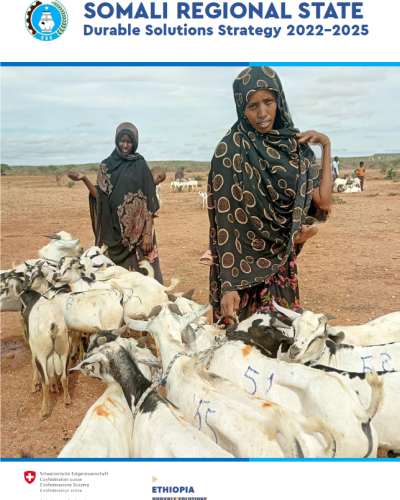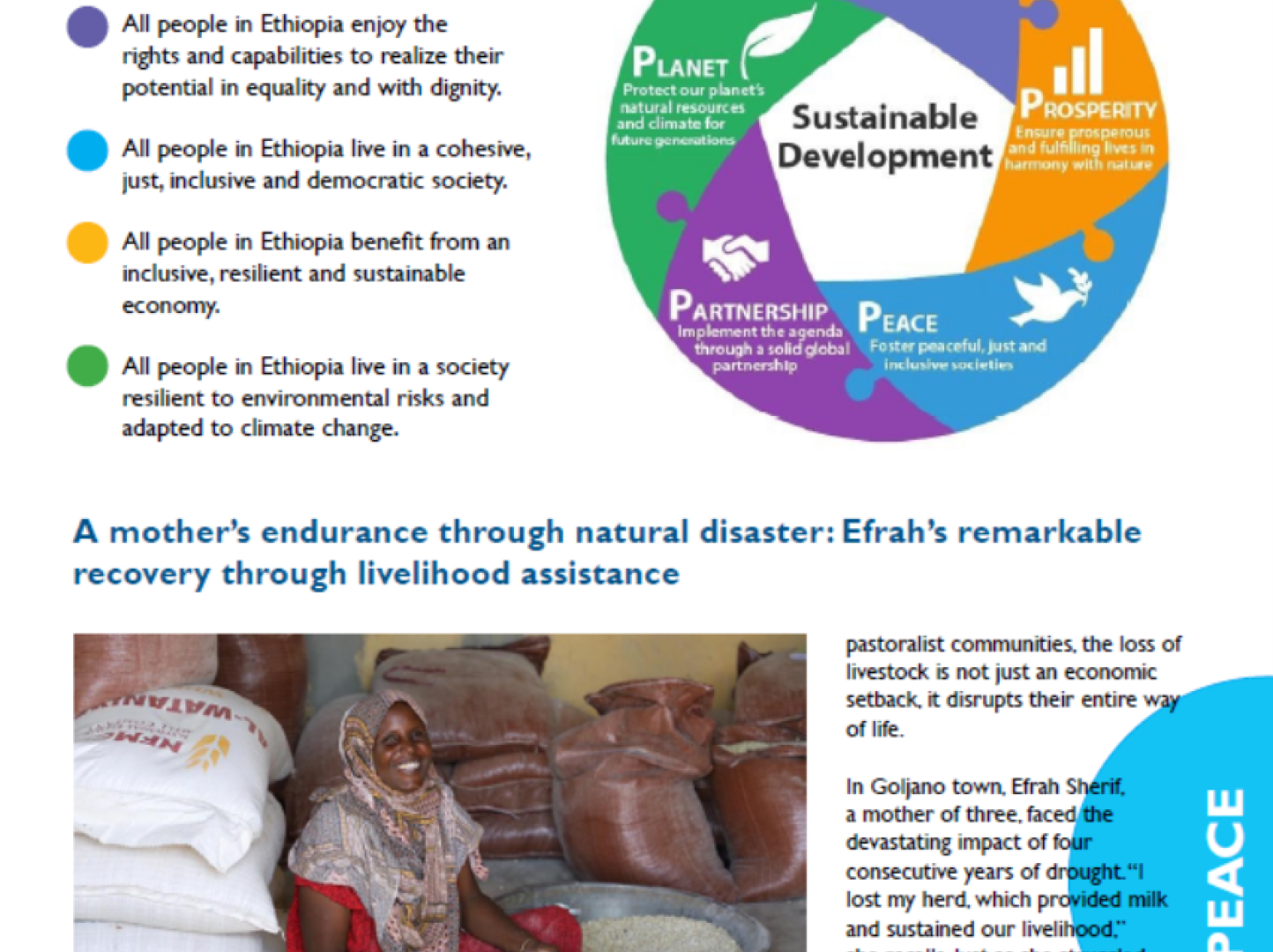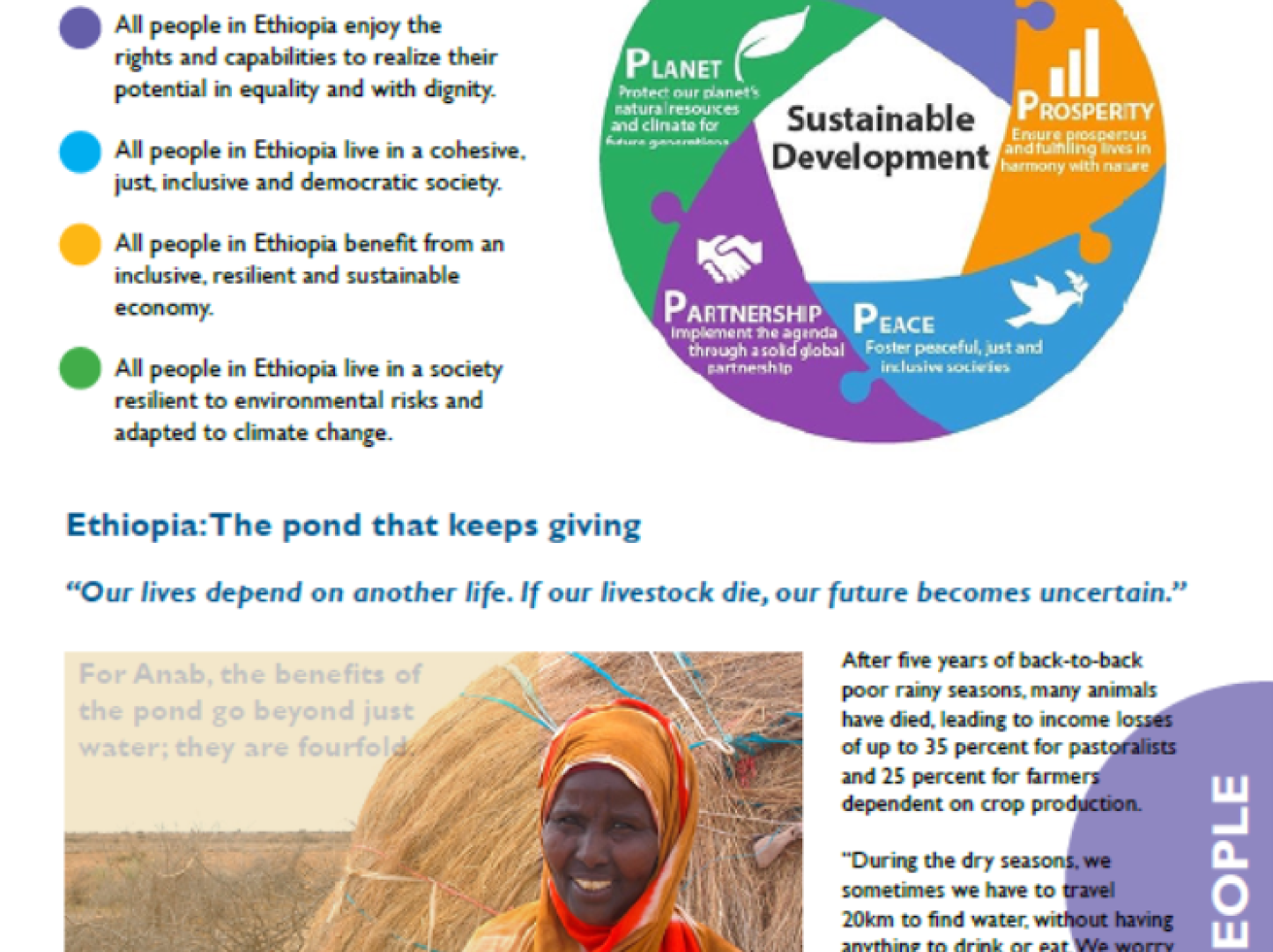Somali Regional State Durable Solutions Strategy 2022-2025

Durable Solutions to internal displacement provides a pathway for displacement affected communities to move from dependency on humanitarian, urgent life-saving assistance to a condition of self-sufficiency and, ultimately, resilience. The Federal Government of Ethiopia has made tremendous efforts to advance solutions for internal displacement, including through establishing the Durable Solutions Initiative in 2019 designed to provide a principled operational framework for durable solutions and shape multi-sectoral and collective interventions for return, relocation and local integration of IDPs. Much of this momentum has been seen in the Somali Region.
The Somali Regional Government (GoSR) has made strong advances towards building the architecture to sustain durable solutions through cross government multi-partner interventions. Efforts to support the attainment of durable solutions is exemplified at multiple levels through the establishment of coordination structures under the auspices of the Ethiopia Durable Solutions Initiative to facilitate multistakeholder coordination and areas-based inclusive interventions. Although there are considerable strategic developments, there remains key challenges and barriers that exist.
Issues concerning security dynamics, natural resource management, social and economic fragility, and settlement patterns influence the scale of displacement in the Somali Region. Understanding the root causes of conflicts, and the Region’s susceptibility to climatic disasters would help illustrate a dynamic displacement risk profile for the region that can outline agents for solutions through exploration of the medium and longer term impacts of protracted displacement whether social, environmental, or politically related. Short term interventions driven by sudden recurring emergencies means that longer term planning would be overlooked and neglected. It is therefore vital to recognize that finding durable solutions to forced displacement requires a broad institutional engagement. Durable Solutions require a long-term planning horizon that spans short-term humanitarian assistance through to long term development actions and resilience building. The Somali Region Durable Solutions Strategy 2022-2025 and associated Menu of Options 2022- 2025 objectively sets to establish foundations to engine long term recovery and enable development processes.
In efforts to advance durable solutions to the Region’s situation of protracted displacement the Somali Region Durable Solutions Strategy 2022-2025 has been drafted building on the momentum and advancements of the Durable Solutions Strategy 2017- 2022, supplemented by a revision of the Somali Region Menu of Options 2022-2025. The Strategy has been developed under the leadership of the Somali Regional Government Durable Solutions Steering Committee, chaired by the Office of the Regional President, co-chaired by the Regional Bureau for Disaster Risk Management, and co-secretary by IOM. Technical contribution and advisory support was provided by the Regional Durable Solutions Technical Advisory Group, led by IOM, and co-led by the OWS organization and UNHCR. The Strategy was developed following a series of assessments, surveys, and consultations with government, partners, and representatives from displacement affected communities.
The Strategy is a planning instrument to advance the resolution of internal displacement in the Region and ensure that IDPs, returnees, host communities and other displacement affected populations are provided with solutions to displacement and its impact. The Strategy supports coordination and collaboration between the government at regional, Durable Solutions Strategy 2022-2025 zonal, woreda, and kebele levels and across the international, national, and local aid sector by providing a framework for joint action. The Strategy is expected to contribute to the coherence of regional humanitarian and development planning and delivery across the Somali Region. The rationale for establishing a coherent approach is to ensure partners contributing to solutions to displacement are doing so efficiently, without duplication and with adherence to agreed standards, including those that uphold the rights and provide protection to target groups. In order to establish a coherent, integrated and efficient modality for implementation, the government and partners will work together to establish or strengthen existing nexus considerate policies, methodologies and approaches for creating an enabling environment for solutions in voluntary return, resettlement and local integration areas. By this, the Strategy is premised on the development, implementation and monitoring of localised cooperative action and provides the basis for cooperation between the government, local, and international partners in support of Durable Solutions to displacement in the Somali Region.
Delivering this strategy will thus require coordinated, multi-sectoral and layered interventions. It is framed around facilitating cooperative action, bringing together humanitarian, development, stabilization, and peacebuilding actors, with the government, in joint pursuit of sustainable solutions. Hence, multiple agencies with different sector competencies and approaches (humanitarian, stabilisation, development, peace) will support the interventions laid out within this strategy. Coordination approaches will help to mobilize resources, deter possible duplication, while enhancing collective and synergic concerted action to mobilize, organize, and harmonize activities.
For the purpose of this Strategy durable solutions to displacement is broadly understood to encompass : (i) voluntary return to places of origin, (ii) local integration in areas of displacement, or (iii) relocation in another location within the region. Interventions herein are delineated to reduce risk and vulnerability overtime and raise community selfsufficiency and absorption capacity of hosts, reducing dependency on humanitarian aid and increasing resilience to shocks and stressors. This will enable the development of a safety net system that reduces the need for a recurrent humanitarian assistance introducing solutions considerate operations, policies, and programs aimed at building resilience to future climatic, economic, and conflict induced shocks; and in turn contribute to the generation of the Region’s social, human, financial, and natural resource capital.
The Strategy will act as the regional roadmap articulating a vision to guide progress towards durable solutions over a three -year period. It expects to pave progressive realization of solutions that will involve the employment of approaches that are pre-emptive rather than reactive, holistic, long term and gradual- combining relief and development interventions from the onset. In the context of global commitments to strengthen the humanitarian, development, peace nexus the Strategy is predicated on the principle that durable solutions is a distinct phase acting as the ‘missing middle’ between the different phases of crises provided on the one hand a step out of dependence on humanitarian aid and acute vulnerability on the one hand and laying the foundation for long term recovery and stabilization.
The Strategy is grounded in the Inter-Agency Standing Committee (IASC) Framework on Durable Solutions for Internally Displaced Persons (hereinafter referred to as “IASC Framework on Durable Solutions”) and is in line with the NDRMC Strategy to Address Internal Displacement 2019, and the Humanitarian Country Team (HCT) Protection Strategy’s strategic objective to integrate the centrality of protection in the transition towards durable solutions. This strategy is also designed to bridge the Humanitarian Response Plan (HRP) and United Nations Sustainable Development Cooperation Framework (UNSDCF), by providing a transitional approach that focuses on the resolution of protracted displacement through effective joint programming and supporting the achievement of development objectives in the longer-term. The Strategy centralizes the protection of civilians, seeking to ensure that the rights of individuals supported by durable solutions programmes are respected and that their safety and dignity is maintained. Action put forward as part of this strategy ensures the physical safety, legal protection, and dignity of affected individuals. In respecting protection and conflict sensitivity principles, and employing area-based approaches to durable solutions, all displacement-affected communities, independent of their displacement status, will be supported through the multi-sectoral support described herein.
Instrumental to the achievement of solutions the Strategy puts forward strategic objectives outlined through the attainment of a set of priority areas that seek to address barriers. The achievement of these objectives will be accomplished through localized planning, implementation and monitoring, jointly with government, affected communities, and partners. As such, in recognition of the significant ongoing work that contributes to solutions for IDPs in the Somali Region, this Strategy builds on existing projects, resources, coordination mechanisms and methodologies to the greatest possible extent, while avoiding duplication of effort.




















